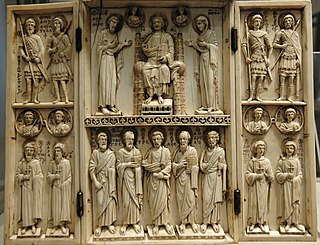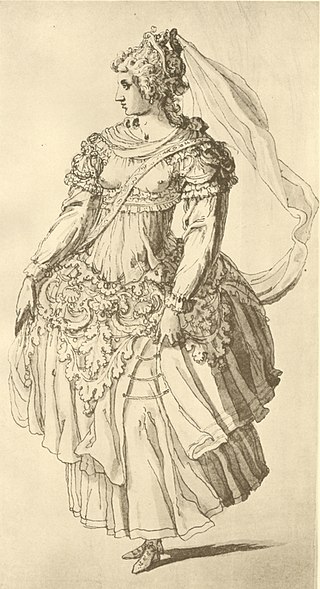
The mitre or miter is a type of headgear now known as the traditional, ceremonial headdress of bishops and certain abbots in traditional Christianity. Mitres are worn in the Catholic Church, Eastern Orthodox Church, Oriental Orthodox Churches, the Anglican Communion, some Lutheran churches, for important ceremonies, by the Metropolitan of the Malankara Mar Thoma Syrian Church, and also, in the Catholic Church, all cardinals, whether or not bishops, and some Eastern Orthodox archpriests.

The Holy Crown of Hungary, also known as the Crown of Saint Stephen, named in honour of Saint Stephen I of Hungary, was the coronation crown used by the Kingdom of Hungary for most of its existence; kings were crowned with it since the twelfth century. The Crown symbolized the King's authority over the Lands of the Hungarian Crown, and it was a key mark of legitimacy. Through the history of Hungary, more than fifty kings were crowned with it, with the last being Charles IV in 1916. The only kings not so crowned were Wladyslaw I, John Sigismund Zápolya, and Joseph II.
The chlamys was a type of an ancient Greek cloak. By the time of the Byzantine Empire it was, although in a much larger form, part of the state costume of the emperor and high officials. It survived as such until at least the 12th century AD.

Byzantine dress changed considerably over the thousand years of the Empire, but was essentially conservative. Popularly, Byzantine dress remained attached to its classical Greek roots with most changes and different styles being evidenced in the upper strata of Byzantine society always with a touch of the Hellenic environment. The Byzantines liked colour and pattern, and made and exported very richly patterned cloth, especially Byzantine silk, woven and embroidered for the upper classes, and resist-dyed and printed for the lower. A different border or trimming round the edges was very common, and many single stripes down the body or around the upper arm are seen, often denoting class or rank. Taste for the middle and upper classes followed the latest fashions at the Imperial Court.
The Council of Hieria was a Christian council of 754 which viewed itself as ecumenical, but was later rejected by the Second Council of Nicaea (787) and by Roman Catholic and Eastern Orthodox churches, since four of the five major patriarchs refused to participate. However it is preferred over Second Nicaea by some Protestants. The council was significant in the controversy of Byzantine iconoclasm, condemning the veneration and production of religious icons as idolatrous and pagan, reflecting Byzantine Emperor Constantine V's iconoclasm. This council declared itself the 'Seventh Ecumenical Council'.
Prōtospatharios was one of the highest court dignities of the middle Byzantine period, awarded to senior generals and provincial governors, as well as to foreign princes.
For most of its history, the Eastern Roman (Byzantine) Empire did not use heraldry in the Western European sense of permanent motifs transmitted through hereditary right. Various large aristocratic families employed certain symbols to identify themselves; the use of the cross, and of icons of Christ, the Theotokos and various saints is also attested on seals of officials, but these were often personal rather than family emblems. Likewise, various emblems were used in official occasions and for military purposes, such as banners or shields displaying various motifs such as the cross or the labarum. Despite the abundance of pre-heraldic symbols in Byzantine society from the 10th century, only through contact with the Crusaders in the 12th century, and particularly following the Fourth Crusade (1202–1204) and the establishment of Frankish principalities on Byzantine soil from 1204 onwards, did heraldic uses penetrate in Byzantium. A native Byzantine heraldry began to appear in the middle and lower rungs of aristocratic families in the 14th century, coinciding with the decline of imperial authority and with the fragmentation of political power under the late Palaiologan emperors. However, it never achieved the breadth of adoption, or the systematization, of its Western analogues.

Proedros was a senior Byzantine court and ecclesiastic title in the 10th to mid-12th centuries. The female form of the title is proedrissa (προέδρισσα).
Sebastokrator, was a senior court title in the late Byzantine Empire. It was also used by other rulers whose states bordered the Empire or were within its sphere of influence. The word is a compound of sebastós and krátōr. The wife of a Sebastokrator was named sebastokratorissa in Greek, sevastokratitsa (севастократица) in Bulgarian and sebastokratorica in Serbian.

The Chrysotriklinos, Latinized as Chrysotriclinus or Chrysotriclinium, was the main reception and ceremonial hall of the Great Palace of Constantinople from its construction, in the late 6th century, until the 10th century. Its appearance is known only through literary descriptions, chiefly the 10th-century De Ceremoniis, a collection of imperial ceremonies, but, as the chief symbol of imperial power, it inspired the construction of Charlemagne's Palatine Chapel in Aachen.

The Menologion, Menologium, or Menology of Basil II is an illuminated manuscript designed as a church calendar or Eastern Orthodox Church service book (menologion) that was compiled c. 1000 AD for the Byzantine Emperor Basil II. It contains a synaxarion, a short collection of saints' lives, compiled at Constantinople for liturgical use and around 430 miniature paintings by eight different artists. It was unusual for a menologion from that era to be so richly painted. It currently resides in the Vatican Library . A full facsimile was produced in 1907.

The loros was a long, narrow and embroidered cloth, which was wrapped around the torso and dropped over the left hand. It was one of the most important and distinctive parts of the most formal and ceremonial type of imperial Byzantine costume, worn only by the Imperial family and a few of the most senior officials. It developed out of the trabea triumphalis of the Roman consuls. There were different male and female versions. Byzantine sources speak of the "loros costume" as the loros dictated the rest of the imperial outfit. The slightly less formal, and more secular, imperial costume, which was also that normally worn by high officials on official occasions, was the chlamys costume. Underneath either the loros or the chlamys were worn the divetesion (διβητήσιον), a long silk robe, and a tunic.

The kabbadion was a caftan-like garment of oriental origin which became a standard part of court costume in the last centuries of the Byzantine Empire.

Greek dress refers to the clothing of the Greek people and citizens of Greece from the antiquity to the modern times.
Logariastes was a type of financial official in the Byzantine Empire from the early 11th century onwards, with the task of controlling expenses.

The Romanos Ivory is a carved ivory relief panel from the Byzantine empire measuring 24.6 cm by 15.5 cm and 1.2 cm thick. The panel is currently in the Cabinet des Médailles of Paris. Inscriptions name the figures of the emperor Romanos and his wife Eudokia, who are being blessed by Christ. However, there were two imperial couples by these names and scholars have yet to agree which is shown. It was first believed to represent Romanos IV and therefore dated between 1068 and 1071. Discoveries of other carved relief works in the 20th century led researchers to think that it represents the earlier Romanos II, changing the date of creation to somewhere between 945 and 949.

Byzantine illuminated manuscripts were produced across the Byzantine Empire, some in monasteries but others in imperial or commercial workshops. Religious images or icons were made in Byzantine art in many different media: mosaics, paintings, small statues and illuminated manuscripts. Monasteries produced many of the illuminated manuscripts devoted to religious works using the illustrations to highlight specific parts of text, a saints' martyrdom for example, while others were used for devotional purposes similar to icons. These religious manuscripts were most commissioned by patrons and were used for private worship but also gifted to churches to be used in services.

The coronation was the main symbolic act of accession to the throne of a Byzantine emperor, co-emperor, or empress. Founded on Roman traditions of election by the Senate or acclamation by the army, the ceremony evolved over time from a relatively simple, ad hoc affair to a complex ritual.

Oes or owes were metallic O-shaped rings or eyelets sewn on to clothes and furnishing textiles for decorative effect. Made of gold, silver, or copper, they were used on clothing and furnishing fabrics and were smaller than modern sequins. They were made either from rings of wire or punched out of a sheet of metal.
The skaramangion was a caftan-like tunic in the Byzantine Empire.













